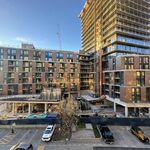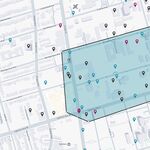Great news. When will they eliminate the senseless stops on the 500 streetcars? 300-350 meter is very reasonable.
They've been gradually eliminating superfluous streetcar and bus stops for at least a couple years now. Most notably on June 7th 2015
all the sunday streetcar stops were eliminated. Streetcar stops are being rationalized as per the
approved board report on streetcar stop spacing. Interestingly that report indicates that the target spacing for streetcar stops is 250-350 metres, not 300-400 metres like I had thought. Yet the stops identified for removal seem more consistent with a 300-400m target.
However, as indicated in that report, the comprehensive review of streetcar stops is being watered down by local interests. We've talked here before about how hospitals are being used as an excuse to keep unbelievably absurd streetcar stops such as Queen & Victoria (90 m from Yonge), and Broadvview & Simpson/Jack Layton (95 m from Gerrard, to be moved to 70 m when the
unwarranted traffic signals are eventually installed). But these are only the most high-profile examples. Local residents, assisted by their councillors, are clinging on to many of the other superfluous stops identified for removal. Interestingly, Steve Munro fits into that group - I gather his stop on Broadview is slated for removal.
He claims that the TTC's review is haphazard and calls into question the notion that removing stops will result in a measurable improvement in travel time.
My guess as to the seemingly haphazard recommendations in the report is that the opponents had begun chipping away before it even went to the board.
Removing mid-block streetcar stops may not have that big of an impact on average travel times, but they should have an impact on reliability and bunching since they tend to be less well used, and therefore disproportionately delay vehicles that already have longer headways. But the main argument for removing them is to reduce the incentive for pedestrians to cross the street at uncontrolled intersections.
Removing stops at signalized intersections results a much greater improvement on travel times, due to signal co-ordination and signal priority, two variables that Munro does not seem to have considered.
Signal Co-ordination
Closely-spaced signals are almost always co-ordinated with one another, which means that travelling non-stop can almost guarantee a green in many cases. For example look at Dundas & Yonge, and Dundas & Victoria eastbound. The signal at Victoria has a much longer east-west green, due to the pedestrian scramble phase at Yonge. So it turns yellow several seconds after the signal at Yonge, allowing eastbound cars to get through both signals in one go. But there's a nearside streetcar stop at Victoria so streetcars almost always arrive on green, then by the time they've finished loading, the light has changed to red and they sit for an additional 20+ seconds waiting for the light to change.
Transit Signal Priority
Removing stops at signals allows the transit signal priority (TSP) at those locations to work more reliably. To work effectively, TSP depends on estimating when a streetcar will wish to pass through the intersection, in order to provide a green at that time. But with a near-side stop, it's anyone's guess when that might be - some streetcars might not stop at all, some might stop briefly to load a couple passengers, and some might stop for a while as someone boards with a stroller or wheelchair, etc. That level of variation is well beyond the tolerances of any TSP system. As a result some streetcars get little benefit from TSP as they take less than the anticipated amount of time (so the system does nothing, thinking they'd get a green anyway), and others get a negative benefit as the signal extends the green to its maximum and the streetcar still hasn't gotten through. In which case it actually increases the delay to them since the light will now change back to green later than it would have otherwise.
Furthermore, TSP at signals with nearside stops extends greens while they are at the stop - it does nothing to help get them there. In contrast, TSP without nearside stops extends greens while streetcars approach the intersection, helping to counteract traffic congestion by clearing out the queues in front of the streetcar. At some intersections it could even provide a left turn phase to clear out cars sitting on the tracks, like Bathurst & Adelaide for example.





